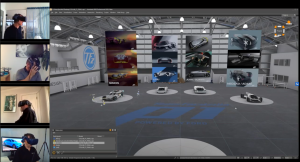& Construction

Integrated BIM tools, including Revit, AutoCAD, and Civil 3D
& Manufacturing

Professional CAD/CAM tools built on Inventor and AutoCAD
2 min read
CarDesignNews.com is doing a series on their livestream broadcast about how various design studios are adapting to the global lockdown, finding new and creative solutions in adversity.
Their May 21 broadcast showcased Ford’s live design review in virtual space. Ford’s designers have taken hardware and VR setups home (with permission!), so they can design and collaborate remotely. Across the Ford team, all chief designers and directors now have VR set-ups globally, because for them, design doesn’t stop during lockdown. If anything, the global teams have faced the challenge with creative solutions. Ford has been able to leverage its lengthy experience in virtual reality, adapting quickly to virtual reality workflows as the world entered various stages of lockdown.
The live design review session, featuring Moray Callum (VP, Ford Design), Amko Leenarts (Design Director, Ford of Europe), Joel Piaskowski (Ford Global Design Director, Cars and Crossovers), and Kemal Curic (Design Director, Lincoln Motor Company), allowed everyone to experience how the Ford team goes through a design review and to learn what aspects of design are important to them.
The review took place in a customized digital environment with 2D references and images and the actual 3D models they were going to review. This means that online viewers can watch the review without 3D equipment, and the team can review and interact with the actual 3D models in real time. Their digital environment looks like an airplane hanger hosting a car show – the depth and space is obvious even to a 2D viewer.

The cars under review in this session were virtual race cars designed by #TeamFordzilla. Ford has started its own e-sports team to race on video platforms. #TeamFordzilla designers have sketched and created virtual models of these cars – all on their own time and for their own interest and fun. The result is incredible, highlighting the way designers work creatively and with personality.
The power and collaborative strength of VRED is really visible here, working with the team’s VR system and allowing designers to present their models even when they don’t have 3D gear. Kemal Curic gave a special shout-out to the fidelity that Autodesk products make possible, as a program like VRED allows designers to look at digital models in a virtual environment, analyzing how different light sources create different reflective patterns across surfaces. This is a unique advantage to the digital software environment, as real-world reviews are limited to the light conditions of a particular environment.
Check it out for an impressive and intimate insight into how Ford used VRED to collaborate remotely in virtual reality. We’re thrilled to see how much they have already made the tool their own, working smarter and faster to be as effective as possible.
By clicking subscribe, I agree to receive the Design Studio newsletter and acknowledge the Autodesk Privacy Statement.
Success!
May we collect and use your data?
Learn more about the Third Party Services we use and our Privacy Statement.May we collect and use your data to tailor your experience?
Explore the benefits of a customized experience by managing your privacy settings for this site or visit our Privacy Statement to learn more about your options.